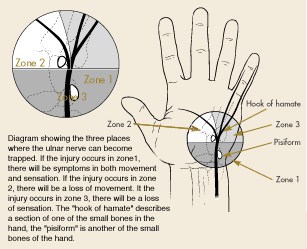Most people are familiar with carpal tunnel syndrome, which can cause numbness and tingling in the hand. A similar condition, called ulnar tunnel syndrome, can cause numbness and tingling that is confined to your little finger and the outside of your ring finger. Unlike carpal tunnel syndrome, however, ulnar tunnel syndrome is not usually caused by repetitive motions.
The ulnar nerve is one of three major nerves that provide sensation and motor function to the hand. It runs down the inside of your forearm to the heel of your hand. Then it branches out across the palm and into the little and ring fingers. Excessive pressure on this nerve can result in a loss of feeling and/or muscle weakness in the hand.
Signs and symptoms
You may or may not have pain in your hand, but you will probably experience weakness and increasing numbness, particularly on the little finger side of the hand. You may experience sensory or motor changes or both, depending on the location of the pressure point. Symptoms develop gradually and can lead to difficulties in opening jars, holding objects, or coordinating your fingers while typing or playing a musical instrument.
Diagnosis
Your physician may examine your hand to see if there are any signs of muscle shrinkage (atrophy) or weakness. To test sensory involvement, he or she may tap a finger over the nerve to see if this produces a tingling sensation (Tinel sign). When you spread your fingers apart, the doctor will look for signs of muscle weakness or dry skin in the spaces between your fingers. Your doctor may prescribe a nerve conduction study to see if the nerve is working properly. A computed tomography scan or a magnetic resonance image (MRI) may be useful in identifying whether a cyst or other growth is putting pressure on the nerve. X-rays can show if you’ve fractured a bone that is now pressing on the nerve. The ulnar nerve also passes through a narrow tunnel at the elbow. Pressure at that point can cause similar symptoms in your hand. So your physician may examine that area as well.
Treatment
 Treatment depends on what’s causing the pressure on the nerve. If pressure results from the way you rest your wrist when typing, a change in position or the addition of some padding may help.
Treatment depends on what’s causing the pressure on the nerve. If pressure results from the way you rest your wrist when typing, a change in position or the addition of some padding may help.
Your doctor may prescribe anti-inflammatory medications such as aspirin or ibuprofen to help alleviate your symptoms, and may recommend that you wear a wrist splint for a time. However, most cases of ulnar tunnel syndrome are caused by a growth in the wrist and must be treated with surgery to remove the growth.
An experienced hand surgeon can remove cysts, scar tissue, or other causes of compression on an outpatient basis. Once the pressure point is removed, you’ll notice an improvement in sensation with a decrease in the numbness and tingling. But it will take several months for the nerve to regrow and heal completely. Your surgeon will make recommendations for postoperative rehabilitation and exercises.
